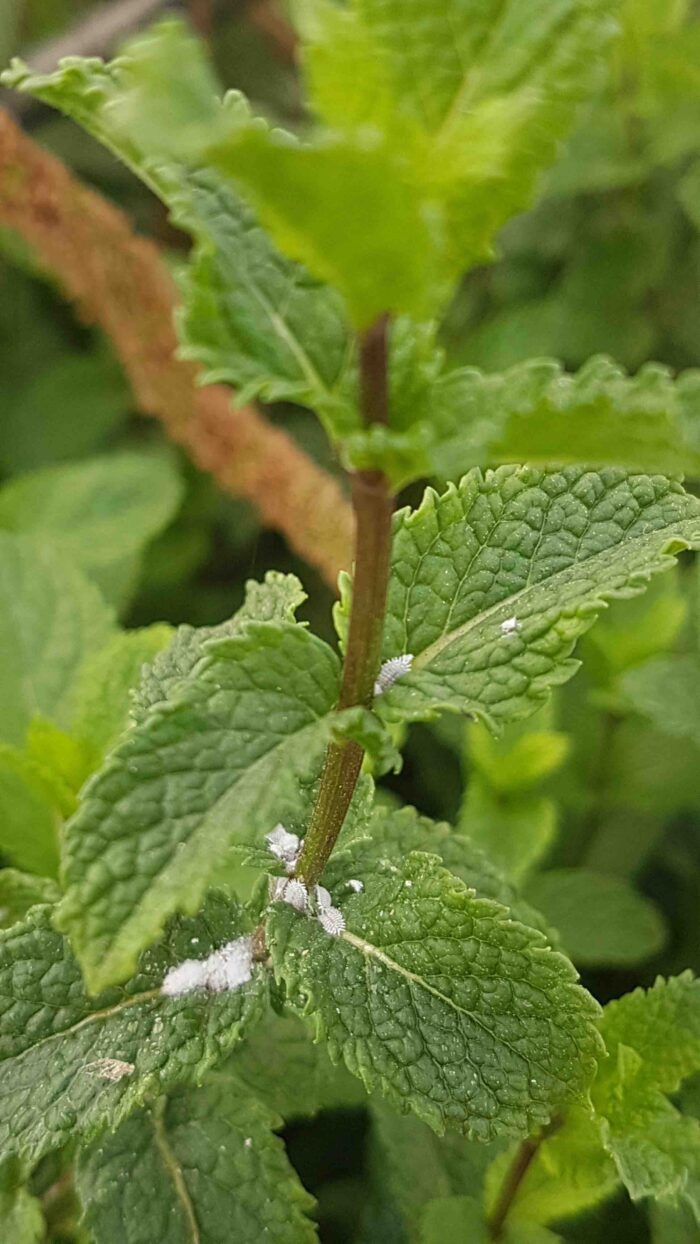चूर्णी मत्कुण
Apple, grapevines, peppers, eggplant, basil, mint, sage, papaya, cucumber, potatoes, barbary fig (and other cactaceae members), rose, mango, pineapple, squash, citrus, sugarcane, coffee, palms, cassava, sunflower, pear, blueberry, raspberry, mulberry, banana, and cocoa
They feed on the phloem by sucking sap from plants. Symptoms appear as small white patches on stems and fruits, followed by the formation of honeydew and the development of sooty mold near infected areas. Mealybugs are known for their ability to transmit plant viruses and can cause heavy losses to economically important crops.
Considered to be a soft scale insects, mealybugs derived their name from their appearance. Usually, mealybugs are covered with a sticky wax floury or cornmeal-like whitish powder. Some species reproduce sexualy, while others are parthenogenic. Mealybugs may be oviparous, viviparous, or ovoviviparous. Their eggs are usually laid in loose masses of cottony wax ovisacs. The flowering and fruiting phases of plants help support a larger mealybug population.
Mealybug species of economical importance include: pink hibiscus mealybug, miscanthus mealybug, papaya mealybug, vine mealybug, and citrus mealybug.
पौषक पौधे के आधार पर चूर्णी मत्कुण के प्रबंधन के तरीके और कुछ हद्द तक उनकी प्रजातियाँ भिन्न-भिन्न होती हैं। ऐसा होने पर भी कुछ उपाय व्यापक हैं।
कीड़ों की आबादी को ट्रैक करने के लिए ट्रैप जैसी पेस्ट निगरानी तकनीकों का उपयोग करें।
बड़े पैमाने पर पकड़ने के लिए डिज़ाइन किये गये व्यावसायिक रूप से उपलब्ध ट्रैपों का उपयोग करें। पारंपरिक उपचार के लिए ट्रैप केवल व्यवस्थित निगरानी दिनचर्या के साथ प्रयोग किये जाने की स्थिति में ही एक उचित विकल्प होते हैं।
नियंत्रण : कीड़ीयाँ चूर्णी मत्कुण की कॉलोनियों के प्रसार और स्थापन में सहायता करती हैं। कीड़ीयाँ मधुरस की ओर आकर्षित होती हैं और उनका चूर्णी मत्कुण दुश्मनों पर दमनात्मक प्रभाव हो सकता है।
स्वच्छता : खरपतवारों, पौधे के अवशेषों, क्षतिग्रस्त भागों, अवांछित पौधों की वृद्धि, और आस-पास के खेती न किये गये क्षेत्रो और असुरक्षित पोधों को हटा कर आस-पास के क्षेत्र साफ रखें।
विश्व के एक अथवा अधिक भागों में प्रयोग किये जाने वाले उत्पादों में निम्न सामग्रियाँ हो सकती हैं :
सल्फ़ोक्साफ्लोर, स्पाइरोटेट्रामत, बुप्रोफ़ेज़िन, चेनोपोडिउम के रस, च्लोर्प्य्रिफ़ोस्, इमिदाक्लोप्रिद, थियमेतोक्साम्, एसेतमिप्रिड्, और थियाकलोप्रिद
नीम तेल, टी-ट्री तेल, खनिज तेल, और डिटर्जेंट (औद्योगिक साबून) जिसे विशेषत: कृषि प्रयोग के लिए डिज़ाइन किया जाता है।
एनजाइर्स सिउदोकोक्की, लेप्तोमस्तिक्स दकताईलोपिल जैसे व्यावसायिक रूप से उपलब्ध लाभकारी किटाणू, और क्रिप्टोलेउमस मोन्त्रुजियारी कॉक्सिनेलिड हिंसक का लार्वा चरण
.
*नोट : प्राकृतिक चूर्णी मत्कुण विरोधियों को छोड़ने से पूर्व चींटीओं की आबादी पर नियंत्रण अत्यंत अनुशंसित है।
*Names marked in red are considered to be highly poisonous to beneficial insects.
*Names marked in green are considered to be organic and IPM (integrated pest management) compatible.
Image Gallery


